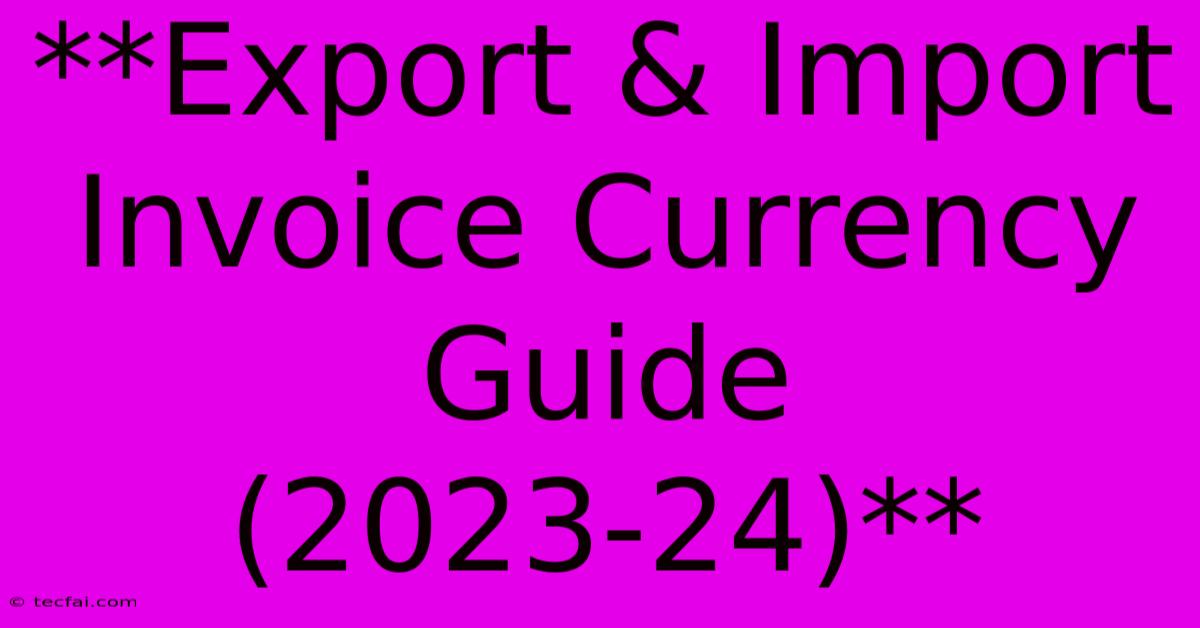**Export & Import Invoice Currency Guide (2023-24)**

Discover more detailed and exciting information on our website. Click the link below to start your adventure: Visit Best Website tecfai.com. Don't miss out!
Table of Contents
Export & Import Invoice Currency Guide (2023-24)
Navigating the world of international trade requires understanding the complexities of currency exchange. One crucial aspect is determining the appropriate currency for your export and import invoices. This comprehensive guide will equip you with the knowledge to confidently choose the best currency for your business, minimizing financial risks and optimizing your profitability.
The Importance of Invoice Currency Selection
Choosing the right invoice currency directly impacts your financial outcomes. Key considerations include:
- Exchange Rate Fluctuations: Volatile exchange rates can significantly impact the final price you receive for your goods or services. By selecting a stable currency, you can minimize potential losses due to fluctuations.
- Payment Terms & Settlement: The agreed-upon currency should align with your payment terms and the preferred method of settlement.
- Client Preferences: Catering to your client's preferred currency can streamline transactions and enhance customer satisfaction.
- Tax Implications: Currency selection may influence tax obligations and reporting requirements in both your country and the trading partner's country.
Choosing the Ideal Currency
Here's a step-by-step approach to selecting the most suitable invoice currency:
-
Analyze Your Business:
- Identify your primary market and the currencies predominantly used in those regions.
- Assess your exposure to exchange rate risk and your tolerance for currency fluctuations.
- Determine the payment terms and preferred settlement methods of your typical clients.
-
Consider the Trading Partner:
- Understand their preferred currency and their willingness to accept other currencies.
- Research any specific regulations or restrictions regarding currency usage in their country.
- Explore potential benefits or risks associated with invoicing in their local currency.
-
Evaluate Currency Stability:
- Research historical exchange rate data for potential currencies and analyze their relative volatility.
- Consider currencies with a stable and predictable exchange rate to minimize financial risk.
-
Negotiate & Agree:
- Clearly communicate your preferred currency and the rationale behind it to your trading partner.
- Negotiate mutually agreeable terms and incorporate them into your commercial invoice.
Popular Invoice Currencies
Here are some of the most commonly used invoice currencies in international trade:
- US Dollar (USD): The US dollar remains the dominant currency in global trade, offering a degree of stability and ease of exchange.
- Euro (EUR): The euro, widely used within the Eurozone, is a significant international currency with relatively low volatility.
- Japanese Yen (JPY): The Japanese yen, known for its stability, is commonly used in Asian trade and for settling certain commodity contracts.
- British Pound Sterling (GBP): The British pound, historically a strong currency, is a key player in global finance and is widely used in international trade.
Strategies for Managing Currency Risk
When dealing with currency fluctuations, consider these strategies:
- Hedging: Implement hedging strategies using forward contracts or options to mitigate exchange rate risk.
- Invoice in a Stable Currency: Choose a stable currency like the US dollar or the Euro to minimize losses due to fluctuations.
- Currency Clauses: Include clauses in your contracts that specify the currency for payment and how potential exchange rate variations will be handled.
Conclusion
Selecting the right invoice currency is a strategic decision that significantly impacts your financial outcomes. By carefully considering the factors discussed above and utilizing appropriate risk management strategies, you can optimize your international trade operations and navigate the complexities of currency exchange with confidence. Remember to stay informed about global economic trends and exchange rate dynamics to make informed decisions and protect your business interests.

Thank you for visiting our website wich cover about **Export & Import Invoice Currency Guide (2023-24)**. We hope the information provided has been useful to you. Feel free to contact us if you have any questions or need further assistance. See you next time and dont miss to bookmark.
Featured Posts
-
Harvey Norman Expands Uk Market Challenges
Nov 07, 2024
-
United Wins Veteran Ends Curse In 193 Games
Nov 07, 2024
-
Canadas Trade Policy After Trumps Win
Nov 07, 2024
-
Aer Cap Files Interim Report For Q3 2024
Nov 07, 2024
-
Bay Area Election Breed Lags In Sf Mayor Race
Nov 07, 2024
